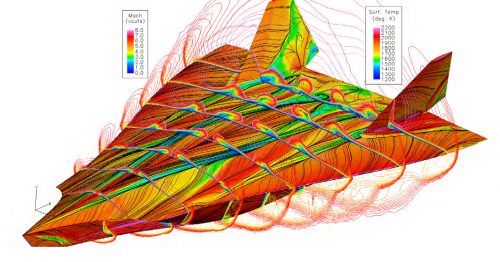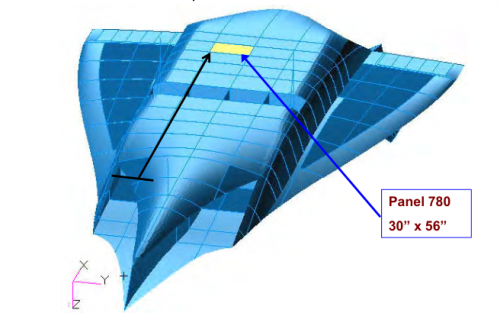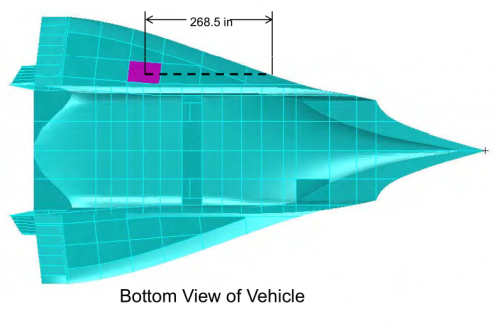The primary purpose of an inlet for an airbreathing propulsion system is to capture and compress air for
processing by the remaining portions of the engine. In achieving this objective, the inlet design must provide for
a minimum weight geometry that enables an efficient compression process, generates low drag, produces nearly
uniform flow entering the combustor, and provides these characteristics over a wide range of flight and engine
operating conditions.
The design of hypersonic inlets is complicated by the many constraints, both aerodynamic and
mechanical, such as starting limits, boundary layer separation limits, constraints on combustor entrance flow
profiles, leading edge radii limits, variable geometry flexibility, and cooling system constraints.
A wide variety of inlet shapes have been explored <...> [including] inlets derived
from streamtubes traced from known parent flowfields. Starting with a known or easily calculated
flowfield, such as the Busemann inlet (=conically symmetric internal compression supersonic inlet), 3D inlets can be derived by tracing streamlines in the parent flowfield and connecting the streamlines to create a streamtube. Using solid walls to encase the streamtube, a 3D inlet shape results that has the same inviscid inlet flowfield and performance characteristics as the parent flowfield.
Tracing three-dimensional inlet shapes from known flowfields has long served as the basis for a powerful inlet
design methodology. If the parent flowfield has high performance, the resulting 3D inlet will likely retain the high performance
characteristics. Further, streamline-traced inlets can often be designed with highly swept leading
edges, which can be beneficial from heat transfer and drag standpoints. Finally, the streamline tracing can be done
in a manner where the resulting inlets are much better suited to self-starting compared the parent flowfield.
The initial interest in inward-turning engine concepts dates to the late 1950s in the United States. <...> the advantage of the inward turning engine concepts are a lower wetted surface area per unit massflow process by the engine. This feature inherently leads to lighter structures, lower heat loads and less frictional losses within the propulsion system.
The disadvantages of the concept include the difficulty associated with incorporation of variable geometry, which leads to challenges associated with starting the engine when high contraction ratios are desired, and the inherent three-dimensional nature of the flowfield, which leads to a requirement for detailed 3D analyses at off-design conditions.
One of the first propulsion systems developed using the streamline tracing of an inward-turning inlet was the
SCRAM missile concept developed by the Johns Hopkins University Applied Physics Laboratory in the early
1960s through the mid 1970s. Development of this modular engine and its successful operation at Mach 5-7.2
speeds validated for the first time the streamline tracing design technique as applied to a scramjet engine.
Interest in inward turning inlet concepts was maintained through the 1990s by small teams of researchers
examining the performance benefits of the concept. Examples of these efforts are the works of Molder4, Kothari5,
and Billig6,7. These analytical works continued to explore the advantages of inward-turning scramjet engine
concepts and their use in novel configuration development.
The Hypersonic Collaborative Australian-U.S. Experiment (HyCAUSE) used these studies as a springboard for
investigation of inward turning scramjet engine concepts8. Within the HyCAUSE program, and inward turning
engine was developed using an inlet design derived from streamline tracing. The inlets were designed for full
capture at Mach 10 operation, and the engine cross-sectional shape was selected to be elliptical based on a desire to
maintain structural efficiency while minimizing the dimension of the combustor cross-section. This inlet geometry
served as the basis for both ground and flight tests.
The streamline tracing technique has been proven to be a powerful design tool for hypersonic inlets, but there are
a number of limitations of conventional streamline-traced designs. When streamline tracing in a parent flowfield that
has uniform inflow and outflow conditions, the resulting inlet must contain the same cross-sectional shape in both
the freestream and at the inlet throat. For example, a rectangular freestream cross-section will have a rectangular
cross-section at the inlet throat and just as a circular free-stream profile will be circular at the throat. Often, one is
interested in designing an inlet with different cross-sectional shapes in the freestream and inlet throat to aid in the
integration of the engine in an airframe. Thus, it is of current interest to develop methodology to morph different
streamline traced designs so that the cross-section of the inlet will go through a shape change. Therefore, it is
necessary to understand the implications of blending streamline traced designs on inlet performance and the extent
to which the flow can be transitioned between two different streamline traced designs before dramatic losses are
incurred.

















